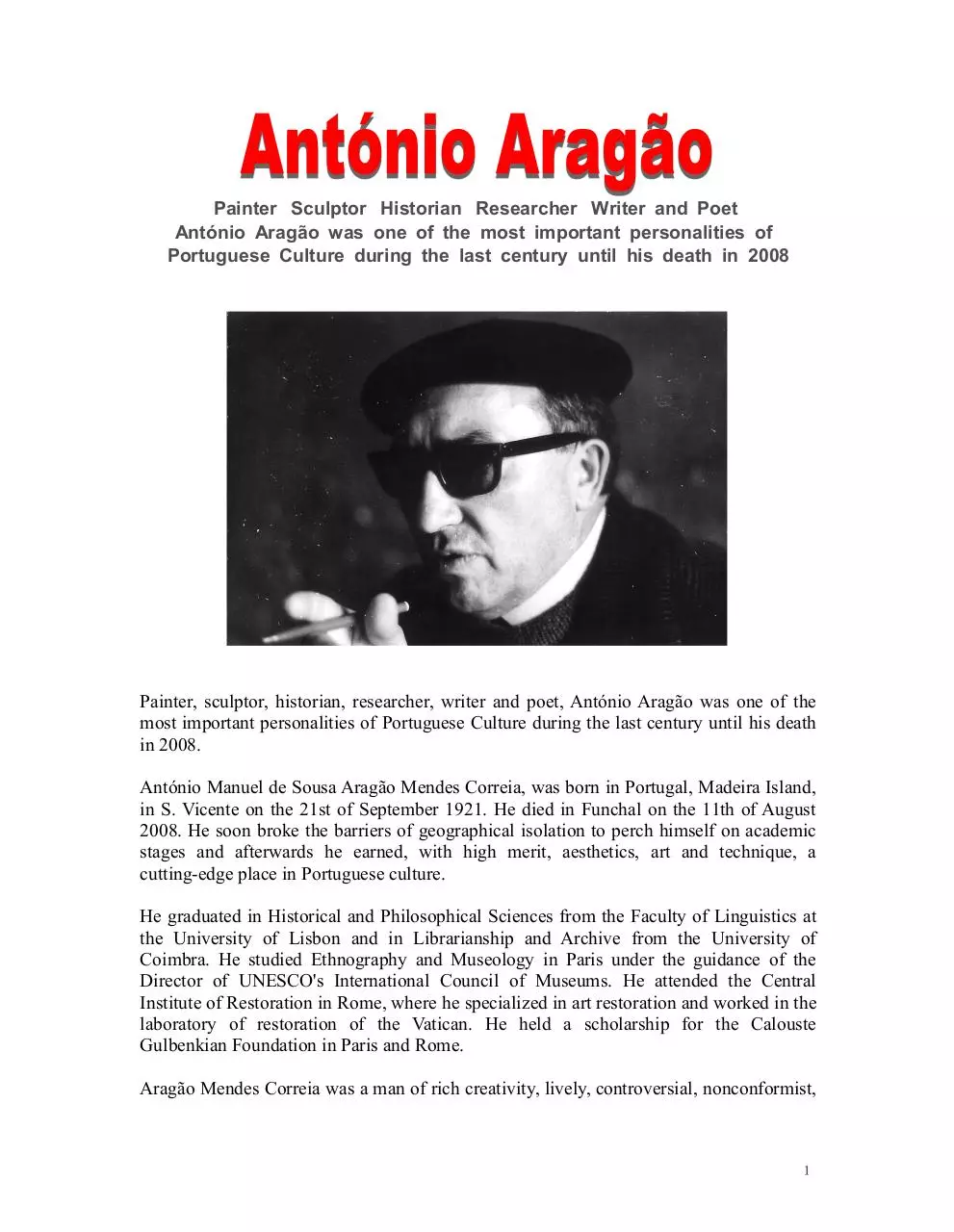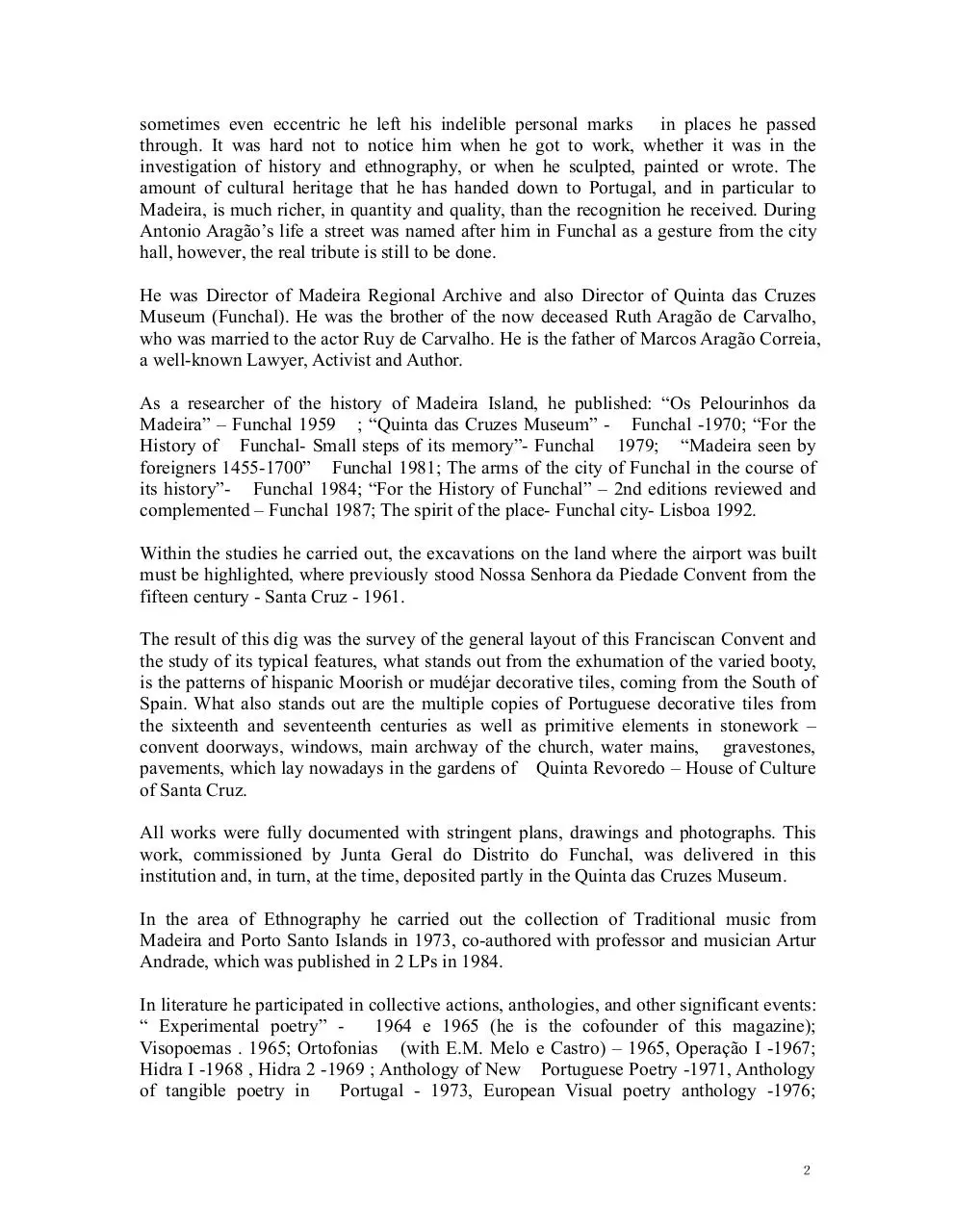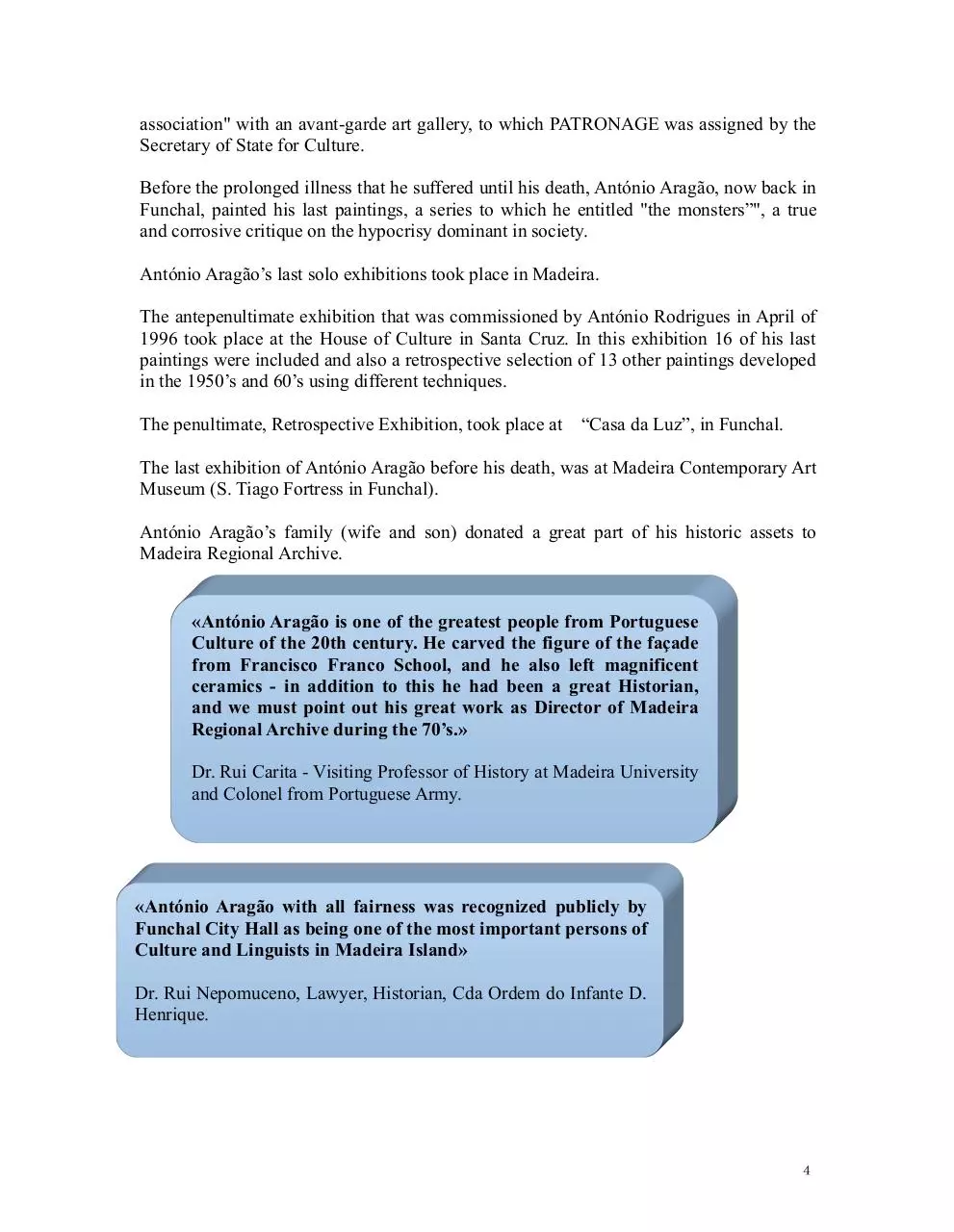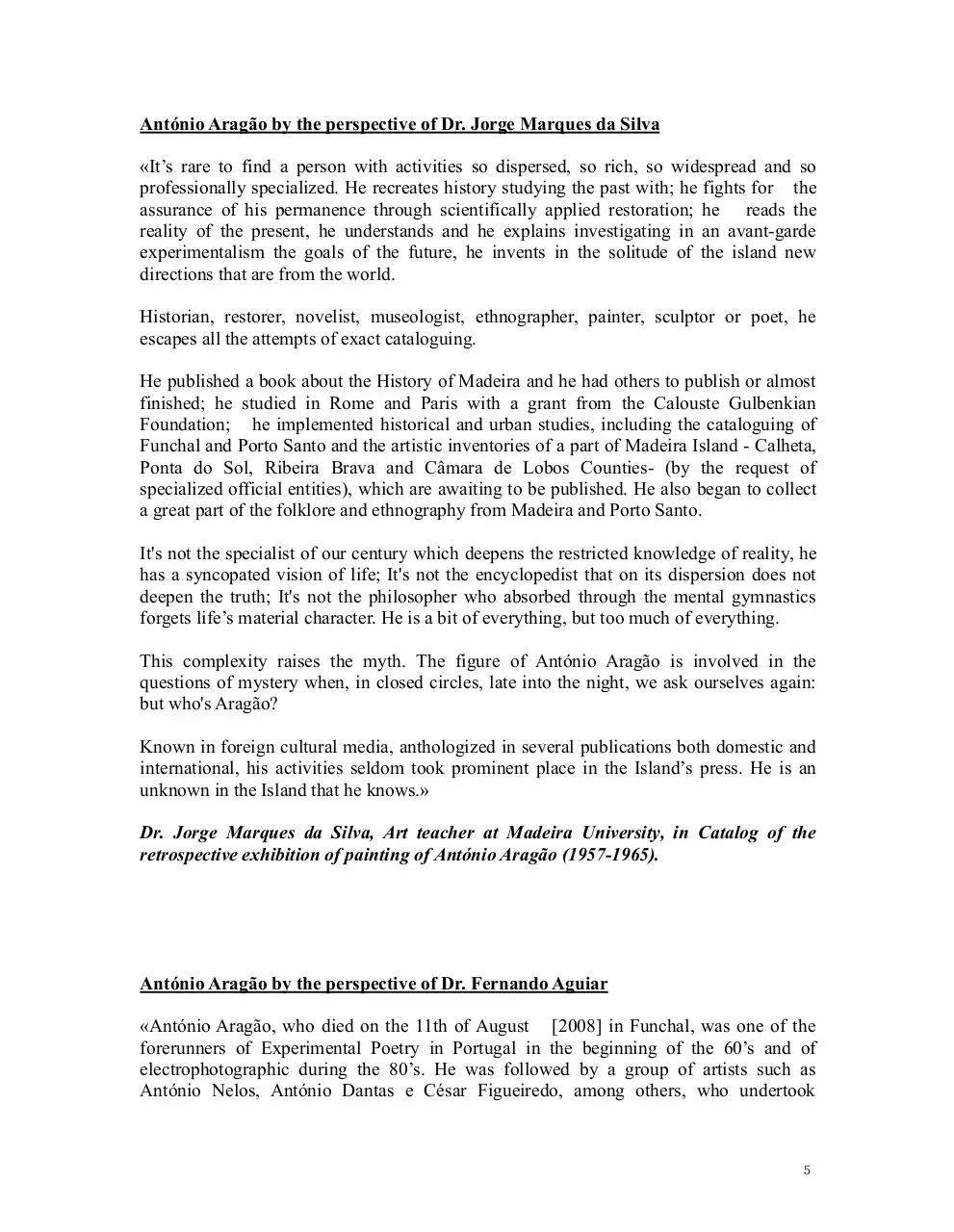English Document ANTONIO ARAGAO (PDF)
File information
Title: �
Author: MarcosAragãoCorreia
This PDF 1.7 document has been generated by WPS Office / , and has been sent on pdf-archive.com on 13/12/2014 at 01:05, from IP address 82.154.x.x.
The current document download page has been viewed 714 times.
File size: 21.2 MB (24 pages).
Privacy: public file





File preview
Painter Sculptor Historian Researcher Writer and Poet
António Aragão was one of the most important personalities of
Portuguese Culture during the last century until his death in 2008
Painter, sculptor, historian, researcher, writer and poet, António Aragão was one of the
most important personalities of Portuguese Culture during the last century until his death
in 2008.
António Manuel de Sousa Aragão Mendes Correia, was born in Portugal, Madeira Island,
in S. Vicente on the 21st of September 1921. He died in Funchal on the 11th of August
2008. He soon broke the barriers of geographical isolation to perch himself on academic
stages and afterwards he earned, with high merit, aesthetics, art and technique, a
cutting-edge place in Portuguese culture.
He graduated in Historical and Philosophical Sciences from the Faculty of Linguistics at
the University of Lisbon and in Librarianship and Archive from the University of
Coimbra. He studied Ethnography and Museology in Paris under the guidance of the
Director of UNESCO's International Council of Museums. He attended the Central
Institute of Restoration in Rome, where he specialized in art restoration and worked in the
laboratory of restoration of the Vatican. He held a scholarship for the Calouste
Gulbenkian Foundation in Paris and Rome.
Aragão Mendes Correia was a man of rich creativity, lively, controversial, nonconformist,
1
sometimes even eccentric he left his indelible personal marks in places he passed
through. It was hard not to notice him when he got to work, whether it was in the
investigation of history and ethnography, or when he sculpted, painted or wrote. The
amount of cultural heritage that he has handed down to Portugal, and in particular to
Madeira, is much richer, in quantity and quality, than the recognition he received. During
Antonio Aragão’s life a street was named after him in Funchal as a gesture from the city
hall, however, the real tribute is still to be done.
He was Director of Madeira Regional Archive and also Director of Quinta das Cruzes
Museum (Funchal). He was the brother of the now deceased Ruth Aragão de Carvalho,
who was married to the actor Ruy de Carvalho. He is the father of Marcos Aragão Correia,
a well-known Lawyer, Activist and Author.
As a researcher of the history of Madeira Island, he published: “Os Pelourinhos da
Madeira” – Funchal 1959 ; “Quinta das Cruzes Museum” - Funchal -1970; “For the
History of Funchal- Small steps of its memory”- Funchal 1979; “Madeira seen by
foreigners 1455-1700” Funchal 1981; The arms of the city of Funchal in the course of
its history”- Funchal 1984; “For the History of Funchal” – 2nd editions reviewed and
complemented – Funchal 1987; The spirit of the place- Funchal city- Lisboa 1992.
Within the studies he carried out, the excavations on the land where the airport was built
must be highlighted, where previously stood Nossa Senhora da Piedade Convent from the
fifteen century - Santa Cruz - 1961.
The result of this dig was the survey of the general layout of this Franciscan Convent and
the study of its typical features, what stands out from the exhumation of the varied booty,
is the patterns of hispanic Moorish or mudéjar decorative tiles, coming from the South of
Spain. What also stands out are the multiple copies of Portuguese decorative tiles from
the sixteenth and seventeenth centuries as well as primitive elements in stonework –
convent doorways, windows, main archway of the church, water mains, gravestones,
pavements, which lay nowadays in the gardens of Quinta Revoredo – House of Culture
of Santa Cruz.
All works were fully documented with stringent plans, drawings and photographs. This
work, commissioned by Junta Geral do Distrito do Funchal, was delivered in this
institution and, in turn, at the time, deposited partly in the Quinta das Cruzes Museum.
In the area of Ethnography he carried out the collection of Traditional music from
Madeira and Porto Santo Islands in 1973, co-authored with professor and musician Artur
Andrade, which was published in 2 LPs in 1984.
In literature he participated in collective actions, anthologies, and other significant events:
“ Experimental poetry” 1964 e 1965 (he is the cofounder of this magazine);
Visopoemas . 1965; Ortofonias (with E.M. Melo e Castro) – 1965, Operação I -1967;
Hidra I -1968 , Hidra 2 -1969 ; Anthology of New Portuguese Poetry -1971, Anthology
of tangible poetry in
Portugal - 1973, European Visual poetry anthology -1976;
2
Portuguese poetry anthology. 1940-1977. 1979; Anthology of Surrealist Poetry in
Portugal; OVO/POVO 1978. Lisbon and 1980, Coimbra; PO.EX. 80 - National
Gallery of Modern Art, Lisbon - 1980 e 1981 ; Filigree. (Journal of international
expansion). Co-founder - 1981, Funchal; Portuguese lyrics – Anthology - 1983;
Poemografias - 1985; I International Lively Poetry Festival 1987, Figueira da Foz;
Poetry: other writings, New supports -1988 -Setúbal; Electroarte - Commun Grave.
Lisbon - 1994.
At an international level his participation in the following must be pointed out: Seville
1980; in Italy and Brazil 1982; 1983, Cuenca; 1984, Commune of Milan - Italy ; 1984,
San Francisco, U.S.A. and Barcelona; 1985, Israel and New York; 1986, México and
Seville; 1987, México and France; 1989, Italy and Paris; 1990, Siegen - Germany,
México and Washington - U.S.A.; and 1992, Madrid.
He collaborated in various demonstrations of Mail-Art and Exchange, spreading his work
in specialty magazines. He wrote for “Comércio do Funchal” ; Línea Sud - Naples; Letras
e Artes - Lisbon; Express; Colóquio-Artes/Calouste Gulbekinan Foundation; Diário de
Notícias – Lisbon ; Comercio do Porto; Espaço Arte. I.S.A.P.M. and Diário de Notícias
-Funchal.
In fiction we must point out: Romance of Izmorfismo - 1964; A hole in the mouth - 1971;
The 3 Farros (with Alberto Pimenta), 1984; Apocalipse Texts - 1992.
In the area of poetry we must refer to: First Poem -1962; Folhema I and Folhema II -1966;
More exactly p(r)o(bl)ems -1968; Blue and White Poem - 1971. Banks - 1975; Space
Poetry POVO/OVO (áudio-visual), 1977; Matenemas, 1981; Pátria, Couves, deus, etc,
com Tesão, Política, Detergentes, etc, 1993; Joyciaba - In Joycina -1982.
For theater he wrote the NAKED disaster in 1980 that won the National Prize.
As an artist he stood out both in painting and sculpture. As a sculptor he is noted for
Santana, in hard stonework, in Santana City Hall - 1959; He is also renowned for the
following works: the monument that commemorates the 5th centenary of the death of
Henry the Navigator, the sculpture in stone that was part of the project leaded by the
architect Chorão Ramalho, Porto Santo 1960; the bas-reliefs in polychromatic ceramic
allusive to the work in the sea and agricultural activities, that is located in the Municipal
Market of Santa Cruz, 1962.
In painting he has been renowned since the 1940’s, due to different themes covered and
the study of distinguished techniques. He carried out several exhibitions in Portugal
(Divulgação Art Gallery, Quadrante, Galeria III, Diferença Art Gallery, Calouste
Gulbenkian Foundation – II Portuguese Painting Exhibition) and abroad – Spain (Madrid,
Seville, Barcelona) ; Mexico, France (Paris); Italy (Rome and Turin).
António Aragão completed a contemporary art project based on new technologies, in a
house that he owned, at Lapa, in Lisbon. The project encompassed a "popular education
3
association" with an avant-garde art gallery, to which PATRONAGE was assigned by the
Secretary of State for Culture.
Before the prolonged illness that he suffered until his death, António Aragão, now back in
Funchal, painted his last paintings, a series to which he entitled "the monsters”", a true
and corrosive critique on the hypocrisy dominant in society.
António Aragão’s last solo exhibitions took place in Madeira.
The antepenultimate exhibition that was commissioned by António Rodrigues in April of
1996 took place at the House of Culture in Santa Cruz. In this exhibition 16 of his last
paintings were included and also a retrospective selection of 13 other paintings developed
in the 1950’s and 60’s using different techniques.
The penultimate, Retrospective Exhibition, took place at
“Casa da Luz”, in Funchal.
The last exhibition of António Aragão before his death, was at Madeira Contemporary Art
Museum (S. Tiago Fortress in Funchal).
António Aragão’s family (wife and son) donated a great part of his historic assets to
Madeira Regional Archive.
«António Aragão is one of the greatest people from Portuguese
Culture of the 20th century. He carved the figure of the façade
from Francisco Franco School, and he also left magnificent
ceramics - in addition to this he had been a great Historian,
and we must point out his great work as Director of Madeira
Regional Archive during the 70’s.»
Dr. Rui Carita - Visiting Professor of History at Madeira University
and Colonel from Portuguese Army.
«António Aragão with all fairness was recognized publicly by
Funchal City Hall as being one of the most important persons of
Culture and Linguists in Madeira Island»
Dr. Rui Nepomuceno, Lawyer, Historian, Cda Ordem do Infante D.
Henrique.
4
António Aragão by the perspective of Dr. Jorge Marques da Silva
«It’s rare to find a person with activities so dispersed, so rich, so widespread and so
professionally specialized. He recreates history studying the past with; he fights for the
assurance of his permanence through scientifically applied restoration; he reads the
reality of the present, he understands and he explains investigating in an avant-garde
experimentalism the goals of the future, he invents in the solitude of the island new
directions that are from the world.
Historian, restorer, novelist, museologist, ethnographer, painter, sculptor or poet, he
escapes all the attempts of exact cataloguing.
He published a book about the History of Madeira and he had others to publish or almost
finished; he studied in Rome and Paris with a grant from the Calouste Gulbenkian
Foundation; he implemented historical and urban studies, including the cataloguing of
Funchal and Porto Santo and the artistic inventories of a part of Madeira Island - Calheta,
Ponta do Sol, Ribeira Brava and Câmara de Lobos Counties- (by the request of
specialized official entities), which are awaiting to be published. He also began to collect
a great part of the folklore and ethnography from Madeira and Porto Santo.
It's not the specialist of our century which deepens the restricted knowledge of reality, he
has a syncopated vision of life; It's not the encyclopedist that on its dispersion does not
deepen the truth; It's not the philosopher who absorbed through the mental gymnastics
forgets life’s material character. He is a bit of everything, but too much of everything.
This complexity raises the myth. The figure of António Aragão is involved in the
questions of mystery when, in closed circles, late into the night, we ask ourselves again:
but who's Aragão?
Known in foreign cultural media, anthologized in several publications both domestic and
international, his activities seldom took prominent place in the Island’s press. He is an
unknown in the Island that he knows.»
Dr. Jorge Marques da Silva, Art teacher at Madeira University, in Catalog of the
retrospective exhibition of painting of António Aragão (1957-1965).
António Aragão by the perspective of Dr. Fernando Aguiar
«António Aragão, who died on the 11th of August [2008] in Funchal, was one of the
forerunners of Experimental Poetry in Portugal in the beginning of the 60’s and of
electrophotographic during the 80’s. He was followed by a group of artists such as
António Nelos, António Dantas e César Figueiredo, among others, who undertook
5
important work in this area, he was the main theoretician.
As an experimental poet António Aragão had a fundamental importance in the creation of
this movement, together with Ana Hatherly, E.M. de Melo e Castro, Salette Tavares, and
José-Alberto Marques, being at the origin of the “Poesia Experimental 1 e 2” (1964 e
1966), “Operação” (1967), Suplemento do “Jornal do Fundão” (1965) e da “Hidra 2”
(1969) magazines.
He was also one of the creators of the first “happening” in Portugal, “Concerto e
Audição Pictórica”, together with E. M. de Melo e Castro, Jorge Peixinho, Salette Tavares,
Manuel Baptista, Clotilde Rosa e Mário Falcão, in 1965.
As a writer António Aragão published “Um Buraco na Boca” [A hole in the mouth]
(1971), the first experimental novel published in Portugal, and some poetry books such as
“Folhema 1” and “Folhema 2”, both from 1966, “Os Bancos” (1975) and “Metanemas”
(1981).
During 1968 he published
“mais exacta mente p(r)o(bl)emas”[more exactly
p(r)o(bl)ems], this was the book which raised interest in experimental poetry, and is one
of the fundamental books in my training as a visual poet. As I had mentioned several
times it was included in a Congress at Mexico City where we both took part. I write out
the preface of my book : “Os olhos que o nosso olhar não vê” [the eyes that our sight
doesn’t see]: “A very special greeting for António Aragão, because, with his book
“MAIS EXACTA MENTE P(R)O(BL)EMAS” ”[more exactly p(r)o(bl)ems] that I bought
in a used bookstore when I was sixteen (together with “POEMAS POSSÍVEIS”
[POSSIBLE POEMS] from an unknown poet who is today is a Nobel laureate) he took
me irreparably to this form of poetic expression.”
The work of the António Aragão has not yet been studied adequately to be given the
importance it deserves in contemporary poetry in Portugal.
I've always had tremendous admiration and friendship for Aragão who participated in
more than three dozen activities organized by me such as Exhibitions, Festivals, poetry
Anthologies and collections of experimental Portuguese poetry published in several
international magazines and I prefer to leave here some previously unseen images of this
important creator and friend.»
Dr. Fernando Aguiar, Art teacher and Artist.
News from Lusa Press Agency on the 11th August 2008
Madeira: António Aragão, great figure of the 20th century culture died
6
Funchal, 11th August (LUSA) - The poet, historian, painter and sculptor from Madeira
Island, António Manuel de Sousa Aragão, 86 years old, deceased today , in Funchal,
illness victim.
Lusa
19:37 Monday, 11th of August 2008
António Aragão distinguished himself in various areas of national and regional culture.
He graduated in History and Philosophic Sciences by from the Classical University of
Lisbon and in Librarianship and Archive from the University of Coimbra.
He trained in France and Italy, in ethnography, museology e and art restoration and as a
painter he exhibit in Barcelona and London and he also participated in avant-garde
experiences in England, Brazil and Italy.
The historian Rui Carita remembered him, to Lusa Press Agency, as a "great friend and
one of the major figures of Portuguese culture of the 20th century."
With "Poema Primeiro", "Folhemas 1,2,3 e and 4", "Mais Exactamente P(r)o(bl)emas",
"Os Bancos e Metanemas" " he was one of the greatest poets from the 60’s".
António Aragão also tried fiction - "Um Buraco na Boca" - and dramaturgy - "Desastre
Nu" - and also left a legacy in sculpture.
"For example, he carved the figure of the façade from Francisco Franco School , having
also left magnificent ceramics - aside from being a great historian", recalls Rui Carita,
who also emphasized "his great job as Director of Madeira Regional Archive, during
the 70’s".
LAR.
LUSA – Portugal Press Agency.
About the Art collection "The monsters"
Transcript about “Os monstros” [The monsters] , by Dra. Isabel Santa Clara
«When the painting [of António Aragão] reappears, in 1992, in a Dionysian shape, he
now does not only use the brush and paint because it is with collages that he organizes his
compositions. In a manner of speaking they are made impulsively.
Here the destruction is really the starting point: he takes lots of newspapers and then he
7
rips, crumples, burns, glues and paints in an unconcerned and quick performance with a
colorful enthusiasm. This series is populated by humans with pig feet, truculent, libertine,
in a wide range of voices, eyes wide open, condemned to wakefulness.
It’s followed by a bestiary no less hallucinatory of monsters without an exact taxonomy
and dogs with their teeth in severe affliction.
The accumulated experiences before, consubstantiate in this series of items to where they
conjoin:
– the resulting languages hybridization including printed texts, that operate
simultaneously as raw material, as plastic elements and as shelter to a lost readability;
– the narrative inherited from the fictional aspect, visible both in the creation of
characters and situations, as in the titles itself: “Now it’s suspicious to have roses”, “In a
rare place without seagulls”, “First the basic needs”, “The unexpected taste of a star”,
“The girls went to see the sea”, “When the lucid mothers became angry”, “The journey
before joy”, “The perfectly unexpected arrival”, “Thinking about cash-flow”, “Without
knowing about exemplary marketing”, “Perhaps it might be in part time”;
– the corrosive humor that crosses many of his texts, plenty of social critics, of rude
vocabulary sometimes vernacular sometimes invented, of a sense of the absurd and the
grotesque inherent to the collective and individual in our everyday lives;
– the pleasure he had for the material side of painting, as well as the recovery of a certain
informalism that characterized mainly the abstract experiences.
These last paintings can be seen, as the summary of his career, because they are directed
to the main aspects of the work of António Aragão.
They appear with the impact of an ultimate torrent that does not have mercy
with troubles and wanders of implementation, but throw himself forwards plenty of
freedom of a journey without return.»
Dr. Isabel Santa Clara, Art teacher at the University of Madeira, in Art Magazine
Margem 2, published in May of 2011 by Funchal City Hall , an edition entirely
dedicated to António Aragão.
The monsters - a portrait of the hypocrisy of society,
by César Rodrigues, Art critic
Fascination with António Aragão...
«The series “Monstros” [Monsters] has a powerful soul making these works the luxury
8
gems of the exhibition. The fascination results from the kind of colors and strong light,
from the information that is transmitted by fragments of glued newspapers and the shape
of the half-human figures that don’t scare; they even have a picturesque aspect (maybe
because the monsters are outside the painting?).
The interpretation might be abusive, but intends to introduce the provocative component
of António Aragão’s work. In fact, alongside of its institutional side (he was the Director
of Madeira Regional Archive, an experience on which he had no particular pleasure to
speak of), from his scientific and pragmatic spirit, António Aragão was an assumed
left-wing provocateur.
The two facets are in fact present in the works displayed at Prazeres Gallery. The
ethnographic, in the watercolors painted during the 60’s are on show in the smallest
exhibition hall, which portray traditional motifs from Madeira, social paintings related to
winemaking, fishing and with religious phenomenon. And the confrontation, as a
perspective of critique of the hypocrisy of human societies, given by the series
“monstros” [monsters], performed during the 90’s [in the biggest exhibition hall].
This exhibition provides the possibility to watch the documentary signed by Luís
Tranquada, ordered by the Gallery for this occasion. In an unadorned aesthetic, the author
received the testimonies of Jorge Marques da Silva, António Rodrigues, Rigo and
António Dantas about different dimensions of the intellectual and artist with which they
shared some experiences: the historian, writer, booster of the Cine Clube and a
controversial and a forward looking man. Statements reveal the restless, multifaceted and
creative person with a taste for the new so much that, as Jorge Marques da Silva says,
about literature, António Aragão destroyed the structures and substituted them with others
creating new shapes, new language, new words, as happens in the fantastic “Um buraco
na boca” [a hole in the mouth], edited in 1971 [novel]
Considering the importance of the multifaceted journey from António Aragão, but mainly
because it is possible to see the impressive series “monstros” [monsters], makes this an
unmissable exhibition, because it will not be surprising that there are fewer and fewer
opportunities to see the works in this series exhibited together.»
César Rodrigues, Art critic, Director of Paralelo 33 - Magazine of ideas, culture and
leisure.
9
Download English Document ANTONIO ARAGAO
English Document ANTONIO ARAGAO.pdf (PDF, 21.2 MB)
Download PDF
Share this file on social networks
Link to this page
Permanent link
Use the permanent link to the download page to share your document on Facebook, Twitter, LinkedIn, or directly with a contact by e-Mail, Messenger, Whatsapp, Line..
Short link
Use the short link to share your document on Twitter or by text message (SMS)
HTML Code
Copy the following HTML code to share your document on a Website or Blog
QR Code to this page

This file has been shared publicly by a user of PDF Archive.
Document ID: 0000198945.